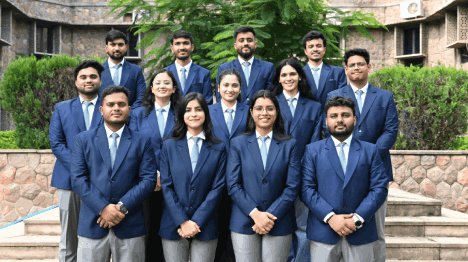- About Us
- Academics
Schools
Programs
General Information
- Faculty
The faculty members and researchers working at IIHMR University come from varied backgrounds including, but not limited to medicine, public health, management, economics, statistics, demography, human geography, social and behavioral sciences, rural development and pharmaceuticals.
- Admissions
- Research
.Publications & Journal
- Executive Education
Executive Programmes
- Online Certification Courses
ONLINE CERTIFICATION Courses
- Training
- Placements
- Fee Payment
- NAAC
- IQAC
- NIRF
- Webinars
- About Us
- About IIHMR University
- Board of Management
- Academic Council
- Board of Studies
- Research Board
- Institutional Review Board
- Finance & Audit Committee
- Departmental Research Committee
- Chairperson's Message
- President's Message
- IIHMR University Act
- Infrastructure
- Collaboration
- Ranking
- Board of Studies (School of Digital Health)
- Awards & Accolades
- Academics
- Institute of Health Management Research
- School of Pharmaceutical Management
- School of Development Studies
- School of Digital Health
- SD Gupta School of Public Health
- MBA (Hospital and Health Management)
- MBA (Pharmaceutical Management)
- MBA (Development Management)
- MBA (Healthcare Analytics)
- Master of Public Health
- Student Manual – Cohort 9 (2021-2023)
- Master of Public Health Offered by Johns Hopkins Bloomberg School of Public Health, USA in cooperation with IIHMR University, Jaipur, India
- Ph. D.
- MBA CSR & ESG Management (Executive)
- MBA Sustainable Business Management (Executive)
- Common Information for all the Programs
- Academic Calendar
- Student Handbook 2020-21
- Committees
- Policies
- Annual Exam Calendar
- Library
- Faculty
- Officers of University
- Dean of Institute of Health Management Research
- Dean of School of Pharmaceutical Management
- Dean of School of Development Studies
- Dean of SD Gupta School of Public Health
- Dean of School of Digital Health
- School of Digital Health
- Faculty List A to Z
- Faculty List Designation Wise
- Faculty List School Wise
- Admissions
- Research
- Executive Education
- Training
- Placements
- Alumni
- Events
- Job Openings
- Contact
- Research
Social Impact Assessment of Prosthetics & Orthotics Programs of Shree Bhagwan Mahaveer Vikalang Sahayata Samiti, Jaipur, Rajasthan.
Agency : Bhoruka Charitable Trust (BCT)
For the last 47 years Bhagwan Mahaveer Viklang Sahayata Sansthan (BMVSS) provided assistive devices like prosthetics, orthotics, and mobility aids free of cost to transform differently abled people to make them mobile and become socially accepted self-contained people. The prosthetic and orthotic rehabilitation services of BMVSS provide complete care of rehabilitation services with promotion, prevention, and assistance to lost or weakened body parts. With this background, BMVSS wants to uncover the truth about what happened to the beneficiaries who received the artificial limbs, callipers, and all other rehabilitation aids in terms of their physical, financial, and social well beings. The BMVSS wants a social impact assessment on the life of the beneficiaries who have started their second life with an artificial limb.
Institute of Health Management Research University (IIHMR-U), Jaipur successfully completed the study on “Social Impact Assessment of Prosthetics & Orthotics Programs of Shree Bhagwan Mahaveer Vikalang Sahayata Samiti, Jaipur, Rajasthan” from the period 10 September to 09 December 2022. The basic objective of the social impact assessments of BMVSS’s program are to understand the social change and impact or consequences (positive and negative, intended, and unintended) arising from the program, plans, policies, and developments.
The universe for the social impact evaluation was the BMVSS program beneficiaries from all over India who visited the BMVSS Centre headquarters at Jaipur during the study period. The study team included the BMVSS beneficiaries who have received artificial limbs in the last 5 years. The study team also interacted with the BMVSS program officials who are working in various capacities (right from doctors to different service providers). The target respondents under the social impact of BMVSS project services were a) the Disabled visiting the BMVSS Centre, Jaipur, for the First-Time b) the Disabled received (last 1 to 5 years back) the artificial limbs from BMVSS Centre, Jaipur c) Service providers of BMVSS, Jaipur Centre officials of various capacities (Technicians, Doctors & other officials). The purposive sampling technique method in selecting the respondents was followed in this study. The total sample covered is 56 disabled people who visited first time at BMVSS for rehabilitation services,111 members who received service at least one year back & re-visit the BMVSS for correction/additional services, and 15 service providers, providing rehabilitation services to the disabled. The Social Impact Assessments (SIA) not only evaluated the social issues of the disabled but also review the environmental impacts and their interactions in the life of disabled persons after having artificial limbs. Its included looking at how these people live in a society (kinship or nuclear setting), culture, community, medical knowledge, and political systems with government legislation and policies that are related to the disabled. The study focused on evaluating the impacts of the BMVSS’s programs and developments on the beneficiaries.
During the study, the activities carried out by the study team are as follows:
- Identified disabled, stakeholders’ groups, and communities impacted by the BMVSS
- Collected baseline data from the disabled covering key social issues such as beneficiaries’ history, culture, and key events that shaped economic and social development, problem, or vulnerabilities
- Identified potential direct social impacts due to rehabilitation service and prediction of the significance of any other
- An overview of government legislation and policies that complement the mitigation measures for social impacts of the
In this study followed a mixed methods approach, with both quantitative & qualitative data collected by study instruments developed for the purpose. To collect quantitative data, a close- ended questionnaire and for qualitative information Key In-depth Interview (KII) and case study were used.



